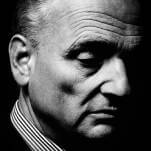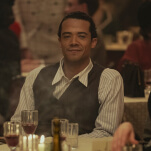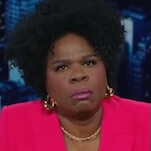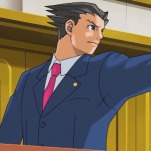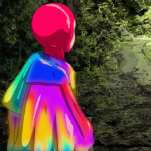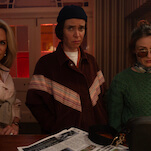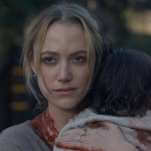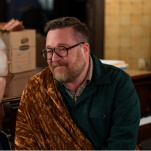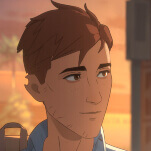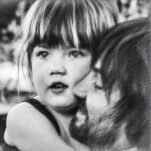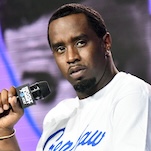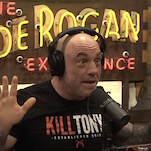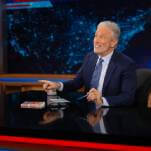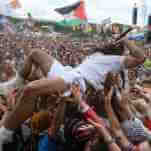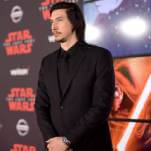Jonathan Ames has written novels and autobiographical essays, and been an experiential journalist and a popular spoken-word attraction. So why not pen a graphic novel? The Alcoholic (Vertigo/DC) is Ames' account of one "Jonathan A," from his first drink through what may be his last. It's a rambling story filled with broad humor, unexpected pathos, and self-absorbed moments that both Ames and his doppelgänger at least have the decency to acknowledge are self-absorbed. (Exhibit A: Pining for a lost love, Jonathan A imagines how bad she'd feel if he had died during 9/11; the book pictures his body lying in the rubble.) As a piece of writing, it's sometimes alarmingly all over the place, affecting when dealing with Jonathan A's strained childhood friendships, then dopey when stalling for a protracted Monica Lewinsky joke. But after a while, that becomes part of the appeal, and part and parcel with the highs and lows of its protagonist's drinking. Dean Haspiel's pared-down, carefully composed art helps smooth over the rough patches and elevate The Alcoholic above the typical confessional comic… B+
When the first issue of Terry Moore's new series Echo came out early this year, we commented that there wasn't much to issue #1, thanks to a thoughtful slice-of-life pace, but that the series would look great in collected form in a year or two. It didn't take nearly that long. Echo: Moon Lake (Abstract) collects the first five issues, which get considerably deeper into the story of a woman who winds up partially coated in symbiotic experimental armor after an ill-advised "let's test this by blowing it to smithereens at high altitude" test. While it isn't nearly as goofy as the first few issues of Moore's signature series, the long-running soap opera Strangers In Paradise, there's a little humor in the way the protagonist, Julie, deals with her weird predicament. And there's a lot of Strangers In Paradise in her angsty, pleading relationship with the estranged husband who's trying to divorce her. But Echo's biggest strength—as usual with Moore—lies in the lovely art and in all the real-world touches that fully ground the science-fiction story. This initial volume is a terrific hook into what so far is a terrific story… A
Robert Kirkman offers a hook of a different kind with the first collected trade of The Astounding Wolf-Man (Image): An initial volume that ends on the series' biggest cliffhanger to date, virtually guaranteeing that anyone who reads the whole thing will be rushing out to pick up the next issue. Even so, the book reads like Kirkman-lite: It's meant for young-adult readers on the particularly young side of the spectrum, and it lacks the detail of his hit The Walking Dead or even the depth of his candy-colored, addictive superhero saga Invincible. The story of a werewolf superhero and his vampire mentor feels like an Invincible subplot—the writing is light, simple, and sleek, and the story blips along quickly, but it feels suspiciously simplistic, a straight-line plot with no nuance, either in the characters or the plot. Eh, if it hooks new readers into Kirkman's generally stellar work, they'll have plenty waiting for them once they're done with this little fillip. If nothing else, Jason Howard's clean, angular art is appealing, in a way that makes this look like the storyboard for a seriously popular, surprisingly dark kids' cartoon… B-
The first issue of Wildstorm's six-part tie-in to the Fox TV series Fringe arrives without much explanation, but apparently the Fringe creative team is following the model of the Heroes comics, by offering a set of evocative vignettes that relate to what's going on in the show, but aren't required reading in any way. Fringe #1 begins with the first part of a serialized story about the college years of the show's crackpot scientist Walter Bishop; the second half of the comic contains a mysterious standalone story about the transference of consciousness from one body to another. What do these stories mean? Hard to say. Perhaps it'll all make sense either when the miniseries is done or the TV show has a few more episodes under its belt. For now, the comic version of Fringe is merely well-drawn and intriguing, but not yet satisfying. Sort of like the TV version, actually… C+
Brian Wood completists are having a good couple of months: First Vertigo re-collects his indie series Demo into a full-size volume, and now Oni has assembled his series Local into one seriously handsome, chunky hardcover collection. Like Demo, Local consists of a series of stand-alone single-issue stories, each taking place in a different city at a different time, but this time they have the (surprisingly tenuous) connection of a central character, a disaffected runaway named Megan. She's often more of an observer and a catalyst than a protagonist, though, whether she's inadvertently winding up at ground zero during a fatal, seemingly long-overdue confrontation between brothers or serving as inspiration—or excuse—for a struggling art student. Even when she is front and center, as in the melancholy story about how she switches identities at will at a movie theater, or a bitter one about her relationship with an eerily anal roommate, Local doesn't really grasp her personality until the conclusion. It's more a series about cities, settings, and people, rather than a novelistic exploration of a single personality. Ryan Kelly, executes each new city with a scribbly, frenetic exactitude that makes each of Rachel's new cities look equally forlorn and depressing, which is much of the point: None of them are home until she figures out what home means. Even though each story could technically stand on its own, they're best read in one breathless sitting, and they probably will be… A-
Rutu Modan's acclaimed graphic novel Exit Wounds offered a fine introduction to her spare style and clear-eyed representation of life, love, and armed conflict in modern Israel, though the story itself played out a little flatly—like a dry, well-meaning indie film. The pre-Exit Wounds collection Jamilti And Other Stories (D&Q;) gives a fuller representation of Modan's talent, jumping from true-crime stories to subtle slices of life, with varying art styles and structural approaches. The book's best story is "Bygone," a tale of insurance fraud and non-traditional families that builds to a touching surprise ending, but really, all seven stories in Jamilti deal smartly and unconventionally with the idea of fluid family relationships and how they influence individual identity. Exit Wounds may have been overpraised, but Modan is still clearly one of the most promising creators working in comics today…A-
After the immersive "on assignment in a repressive country" stories of the superb Pyongyang and Shenzhen, animator/cartoonist Guy Delisle takes it relatively easy in The Burma Chronicles (D&Q;). Delisle accompanied his wife—a Doctors Without Borders administrator—on her 14-month posting in The Union Of Myanmar, but since he wasn't working there in any official capacity, he doesn't have as many anecdotes this time out about dealing with the government via terrified low-level bureaucrats. Instead, he spends most of his days taking care of his infant son and taking note of the petty problems of authoritarian states: Internet filters, censored news reports, power shortages, and the like. At 262 pages, The Burma Chronicles is a little too exhaustive, but the accumulation of detail about supermarkets, bookstores, and local festivals goes a long way toward humanizing a country that barely gets mentioned on the evening news unless something awful is happening there…B+
In Marguerite Abouet and Clément Oubrerie's debut graphic novel Aya, Abouet introduced an eclectic cast of middle-class and scrambling-to-get-by characters living in the Ivory Coast in the late '70s. Aya Of Yop City (D&Q;) picks up where the first book left off, with the teenage title character serving as the calm center of a whirlwind of extramarital affairs, babies born out of wedlock, and her best friend's romance with a rich kid. As with the first book, Yop City suffers some for being so episodic, without a clear beginning or end, but Oubrerie's art retains its delightful mix of cartoony simplicity and vivid detail, and Abouet continues to write these characters as though she just talked to them yesterday. The Aya-verse is getting richer, and more complex… B+
In a memorable passage in Fortress Of Solitude by Jonathan Lethem (we'll review his Omega The Unknown revival next time out), he explores the notion that any group of four characters can be matched up to a personality archetype of The Beatles. (Luke is Paul, Han Solo is John, etc.) Greatest Hits (Vertigo), a new miniseries written by David Tischman (Bite Club) and drawn by Glenn Fabry, runs with that idea, tracing the history of a Beatles-esque team of '60s superheroes called The Mates as it relates to a down-on-his-luck present-day filmmaker. The first issue makes clever connections between familiar superhero types and rock-star archetypes—The Mates even have a Thing-like Pete Best figure—but whether the series makes those connections mean something remains to be seen… B
Just a quick reminder: The 12th and final issue of Grant Morrison and Frank Quitely's All-Star Superman is on the stands now, providing the concluding chapter of a transcendently fine series. Warning: You will believe a fan can cry. A

